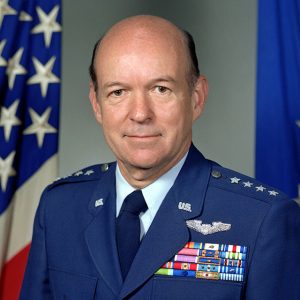calsfoundation@cals.org
William Young Smith (1925–2016)
William Young Smith was a four-star general in the U.S. Air Force who fought in the Korean War before rising to the highest levels of the service. His career culminated with his appointment as the deputy commander of American forces in Europe.
William Young Smith was born on August 13, 1925, in Hot Springs (Garland County), the second of three children of Elizabeth Young Smith and building loan manager Ray S. Smith. (His brother, Ray Sammons Smith Jr., became a noteworthy Arkansas politician.) After graduating from high school in 1943, Smith attended Washington and Lee University for a year before going to the U.S. Military Academy at West Point, New York. After his graduation from West Point in 1948, Smith chose to serve in the U.S. Air Force, which had just been designated a separate armed service.
Smith served at air bases in Texas and Arizona before earning his pilot’s wings in 1949 and then joined the Twentieth Fighter-Bomber Group at Shaw Air Force Base in South Carolina. Shipping overseas in March 1951, Smith did duty as a combat pilot out of Itazuke Air Base in Japan as well as two months as a forward air controller attached to the Twenty-fifth Infantry Division. He was on his ninety-seventh mission in February 1952, fighting with the Forty-ninth Fighter-Bomber Group, when his plane was hit by anti-aircraft fire over North Korea that struck his foot and ankle and set his plane afire. He managed to land on a North Korean mudflat, where U.S. helicopters rescued him and flew him to U.S. lines.
Smith’s wounds led to the amputation of his right foot, and he spent nine months recovering. However, his obituary noted years later, “Gen. Smith’s avocations included tennis and squash. He was quick and agile in competition. Men and women who did not know were said to have been unable to tell, when he walked along a corridor at the Pentagon, which foot was prosthetic.” Though his flying days were at an end, Smith chose to remain in the air force.
He earned a master’s degree at Harvard University before teaching government, international relations, and economics at West Point from 1954 to 1958. He married Maria Petschek in 1957; they had three sons. After attending the Air Command and Staff College from late 1958 to mid-1959, Smith served with the Draper Committee studying the U.S. Military Assistance Program, then as a staff officer with the deputy director of war plans in Air Force headquarters in Washington DC. Smith returned to Harvard, receiving a doctorate in government and political economy, in 1961.
Smith, by then a major, served on the staff of General Maxwell D. Taylor in July 1961 and continued to do so when Taylor was named chairman of the Joint Chiefs of Staff, simultaneously acting as a staff member of the National Security Council—the first military officer to serve in those dual roles. Smith helped negotiate the 1963 Limited Test Ban Treaty, ending such atmospheric nuclear bomb tests as a 1962 one code-named “Arkansas.”
He attended the National War College and, after his 1965 graduation, served at the headquarters of U.S. Air Forces in Europe, becoming chief of the War Plans Division before taking command of the 603rd Air Base Wing at Sembach Air Base in Germany in July 1967. After returning to the United States the following July, Smith was assistant to the Secretary of the Air Force for a year before taking command of the Oklahoma City Air Materiel Area, which supported a variety of weapons systems and support aircraft.
Smith returned to Air Force Headquarters in October 1973, performing duties in policies and planning before becoming the assistant to the Organization of the Joint Chiefs of Staff chairman in late 1975. Promoted to general after returning to Europe as chief of staff for Supreme Headquarters Allied Powers Europe, Belgium, in July 1979, Smith was named Deputy Commander in Chief, U.S. European Command, in June 1981, a post he held until retiring two years later.
In retirement, Smith, whose many service decorations included a Purple Heart, Silver Star, and Air Medal with three oak leaf clusters, was a fellow of the Woodrow Wilson International Center for Scholars and president of the Institute for Defense Analyses, president of the Air Force Historical Foundation, and board member of the National Security Archive. In 1994, he co-wrote, with former Soviet general Anatoly Gribkov, Operation Anadyr: U.S. and Soviet Generals Recount the Cuban Missile Crisis, in which the old Cold Warriors recounted their experiences in the tense 1962 incident.
Smith died of congestive heart failure in Falls Church, Virginia, on January 19, 2016. He is buried in Arlington National Cemetery. He was inducted into the Arkansas Aviation Hall of Fame in 2017.
For additional information:
Abernathy, Mamie Ruth. “A Salute to Native Sons: Distinguished Men of the Armed Forces.” The Record, 1984: 1–20.
Barnes, Bart. “William Y. Smith, Four-Star General, Dies at 90.” Washington Post, January 24, 2016. Online at https://www.washingtonpost.com/local/obituaries/william-y-smith-four-star-air-force-general-dies-at-90/2016/01/24/0ec7eee0-c09e-11e5-bcda-62a36b394160_story.html (accessed April 2, 2022).
“William Young Smith.” Arkansas Aviation Historical Society. https://www.arkavhs.com/general-william-smith (accessed April 2, 2022).
Mark K. Christ
Central Arkansas Library System
 Military
Military World War II through the Faubus Era, 1941 through 1967
World War II through the Faubus Era, 1941 through 1967 William Y. Smith
William Y. Smith 



Comments
No comments on this entry yet.